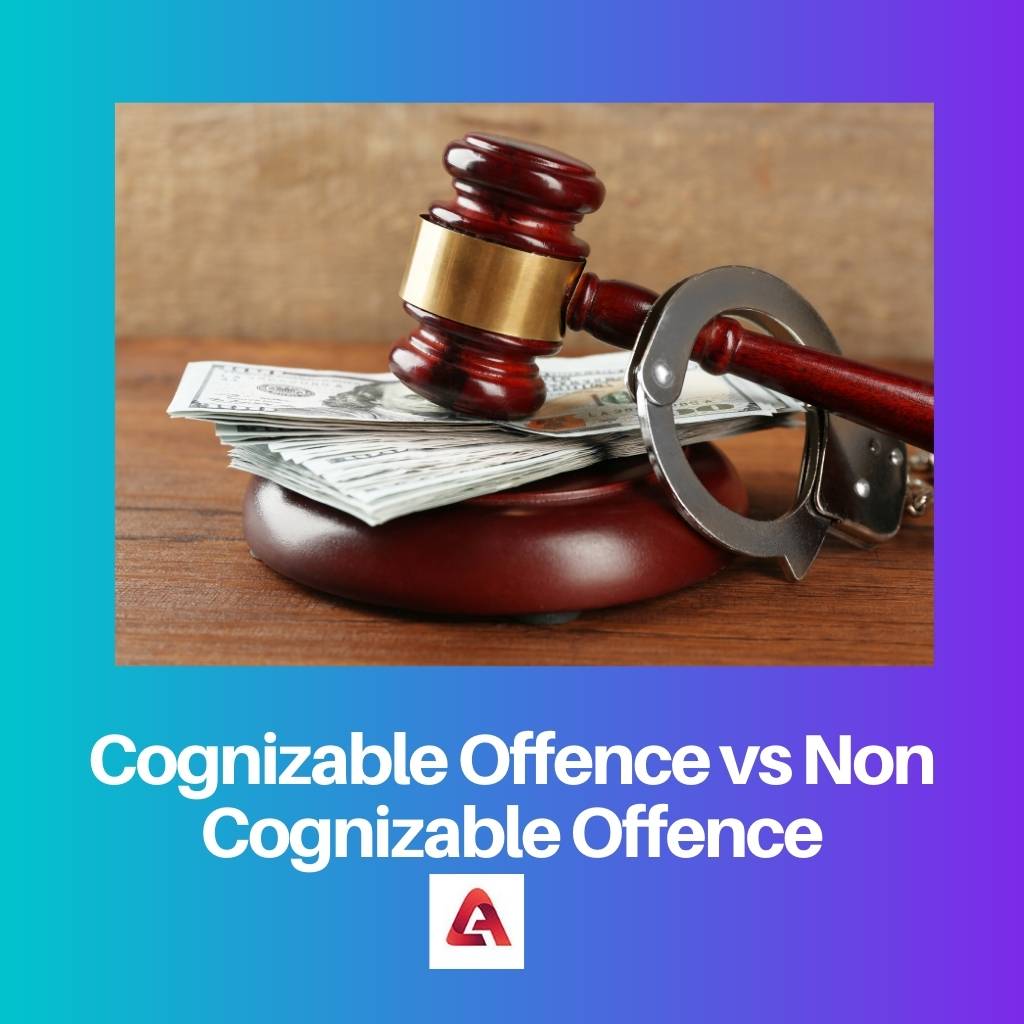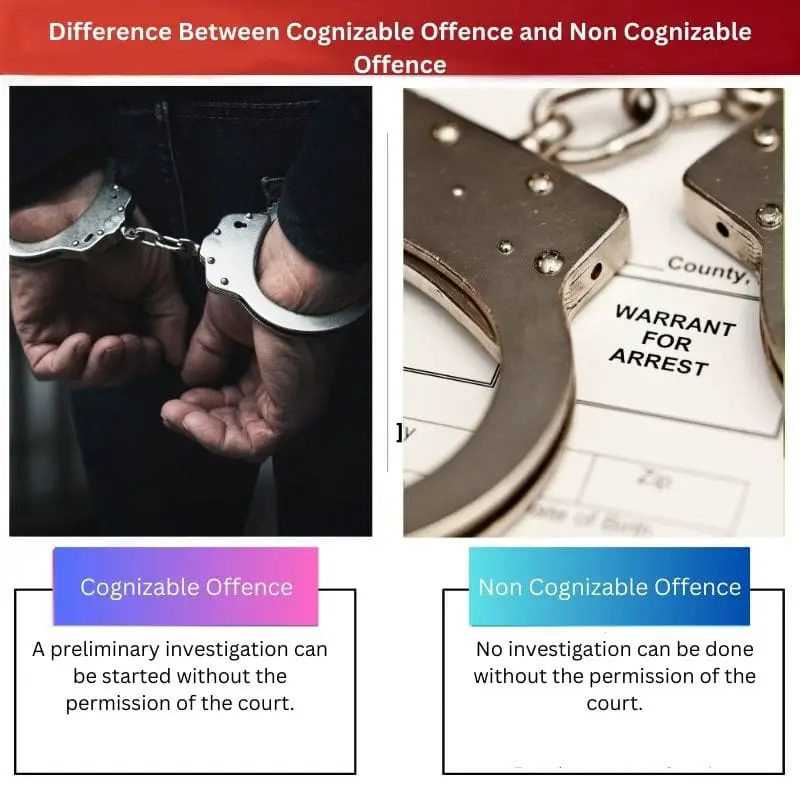We are living in a world where frauds and offences are very common. Daily we read news of some offence that happened in a place. The reason could be anything, technology or irresponsibility.
But the main one is bad intentions or lack of morals. No one learns from birth. Therefore, they can be avoided by giving a proper upbringing to the child.
Not all offences are the same or get the same punishment. They are mainly categorized as Cognizable Offence and Non-Cognizable Offence. Most people are not aware of this and what they mean. Hence, in this article, definitions and differences have been cleared.
Key Takeaways
- Cognizable offenses are serious crimes, allowing police to arrest without a warrant and initiate an investigation.
- Non-cognizable offenses are less severe, requiring a warrant for arrest and a magistrate’s permission to investigate.
- The distinction affects the legal process, police authority, and potential consequences for the accused.
Cognizable Offence vs Non Cognizable Offence
Cognizable offences are those in which the police officer has the authority to arrest the accused without an arrest warrant. It includes heinous crimes such as murder. Non-cognizable offences are those that require an arrest warrant to arrest the accused and include less heinous crimes such as forgery.

Cognizable is the type of offence that is very serious in nature for making the arrest no warrant, no permission is required, and also investigation can be started as soon as the information of the crime is learned. Section 2(c) of the Criminal Procedure Code, 1973 defines this type of offence.
Non-Cognizable Offence is a type of offence that is not serious in nature, and proper procedure is required before making any arrest that includes getting a warrant and permission from the court and is defined under 2(I) under the Criminal Procedure Code 1973.
Comparison Table
| Parameters of Comparison | Cognizable Offence | Non Cognizable Offence |
|---|---|---|
| Warrant | Not required for arrest | Essential for arresting |
| Starting of investigation | A preliminary investigation can be started without the permission of the court. | No investigation can be done without the permission of the court. |
| Magistrate involvement | Permission of magistrate is not required for filling the FIR | Permission is required for filing FIR. |
| Defined under Section | Section 2(c) under Criminal Procedure Code, 1973. | Section 2(I) under Criminal Procedure Code 1973. |
| Crimes example | Murder, rape, dowry death, etc. | Forgery, cheating, defamation, etc. |
What is Cognizable Offence?
It is a type of offence in which a police officer can arrest the convict for investigation; he does not require a court’s permission for the purpose. It is defined under Section 2 (c) of the Criminal Procedure Code 1973. They are heinous crimes, including rape, murder, human trafficking, etc.
The police officer can arrest the convict as soon as the offence is committed. For example: if someone has come to the police station or even the police got news of rape happened, they can make an arrest of the convict without filing any complaint or the FIR and soon start the investigation.
For this, he does not even have to ask for permission from the magistrate. Under this, the convict does not get bail.
Although most people are in favour of this sometimes, as there is no guarantee that the convict accused has actually committed the offence, therefore sometimes, an error can be made, which further results in hatred of the population towards the government and system.
Several amendments have been made to prevent this and make sure the real convicted gets the punishment as soon as possible.

What is Non-Cognizable Offence?
It is a type of offence opposite to the cognizable offence or the offence that is not heinous. They are not very serious in nature. In this type of offence, a proper procedure of making a complaint and filing an FIR is required. This is defined under Section 2(I) under the Criminal Procedure Code 1973.
For example, if someone has committed fraud or cheating, a complaint or FIR has to be filed against the convict, and permission from the magistrate is required to file the FIR. After getting the warrant, the police can start the investigation also before the arrest. Permission from the court is required.
This type of offence includes minor crimes, such as fraud, cheating, defamation, etc. The convict can have bail under this offence.
Therefore the punishment is not very harsh under this type of offence. However, police can take some serious action in case of emergency but cannot make any arrests.
All the rules it has sometimes created disadvantages for the police as the convict can get help or rush as nothing can be done before getting a warrant or permission.

Main Differences Between Cognizable Offence and Non Cognizable Offence
- Under a cognizable offence warrant is not required to arrest the convict; police can arrest him even without it, while a warrant is a must in the case of a Non-cognizable offence. No one can be arrested without a warrant against him.
- Like warrant registration of FIR is not important for starting a preliminary investigation, even though there is no need for permission of a court of the same purpose, while in Non-Cognizable Investigation, permission of the court is a must, no investigation could be done without it.
- If some have done a Cognizable offence, a complaint or Fir can be filed to a magistrate, while in the case of a non-cognizable offence, only a complaint can be filed to a magistrate.
- Cognizable offences are defined under section 2(c) of the Criminal Procedure Code, 1973, while Non-Cognizable Offense is defined under 2(10 of the criminal procedure code, 1973.
- The permission of the magistrate is not required for filing an FIR. In fact, the officer is bound to file FIR in case of a Cognizable Offense, while permission is required before filing an FIR in case of a Non-Cognizable Offense.
- The cognizable offence is a non-bailable offence. Therefore, the convict cannot be granted bail, while under a non-cognizable offence, the convict can get bail as it is a bailable offence.
- The cognizable offence includes heinous crimes such as murder and rape, while the non-cognizable offence includes crimes such as fraud and cheating, i.e., not very serious.

- https://www.jstor.org/stable/43953675
- https://papers.ssrn.com/sol3/papers.cfm?abstract_id=1989629
- https://papers.ssrn.com/sol3/papers.cfm?abstract_id=1989181

This article serves as an educational tool, providing insights into critical legal distinctions between different categories of criminal offenses.
Indeed, understanding these legal nuances is paramount for achieving justice and fairness within the legal system.
Absolutely, this article effectively communicates vital legal knowledge crucial for informed citizenship.
The article explains well the differences between cognizable and non-cognizable offences and the procedures for each. It’s important to educate the public on these distinctions.
I agree, a clearer understanding can help prevent unnecessary arrests and misunderstandings.
Indeed, this knowledge can also help citizens in their interactions with law enforcement.
The article effectively outlines the legal nuances between different types of criminal offenses, promoting legal literacy and awareness.
This knowledge is essential for fostering a more equitable legal system and informed public discourse.
Agreed. It’s imperative for individuals to comprehend the legal implications of different criminal classifications.
The article delivers essential legal knowledge about categorizations of criminal offences, amplifying the public’s understanding of legal processes and rights.
Indeed, this article is pivotal in promoting individual legal literacy and informed engagement with the law.
The article effectively elucidates the differences between cognizable and non-cognizable offences, providing valuable insights into legal distinctions for the readers.
Indeed, this article is informative and contributes significantly to public legal education and awareness.
This article aids in enhancing public legal awareness and understanding of criminal offence classifications.
It’s enlightening to learn about the legal differences and implications of cognizable and non-cognizable offences. This knowledge empowers individuals to comprehend their legal rights.
This article provides crucial information for citizens to navigate their interactions with the law in a responsible manner.
Absolutely, understanding these distinctions contributes to a more informed and just society.
The article aptly conveys the legal distinctions between cognizable and non-cognizable offences, informing readers about the complexities of law in a comprehensible manner.
Absolutely, this article contributes to building a more informed citizenry, promoting legal comprehension and awareness.
The article provides comprehensive information about the legal parameters of cognizable and non-cognizable offences, fostering legal comprehension and awareness among readers.
Absolutely, this article plays a vital role in enhancing public understanding of legal distinctions and complexities.
This article contributes to legal literacy and public awareness, creating a more enlightened population regarding legal classifications.
The distinction between cognizable and non-cognizable offences is elucidated well in this article, shedding light on the complexities of the legal system.
Absolutely, this article helps demystify legal jargon and promotes greater understanding of legal rights and obligations.
The article presents essential legal concepts and distinguishes between cognizable and non-cognizable offences with clarity, filling a gap in public legal education.
This article enhances public legal awareness, fostering a more enlightened society with greater legal understanding.
Agreed. Legal literacy is fundamental for promoting societal well-being and understanding of the law.